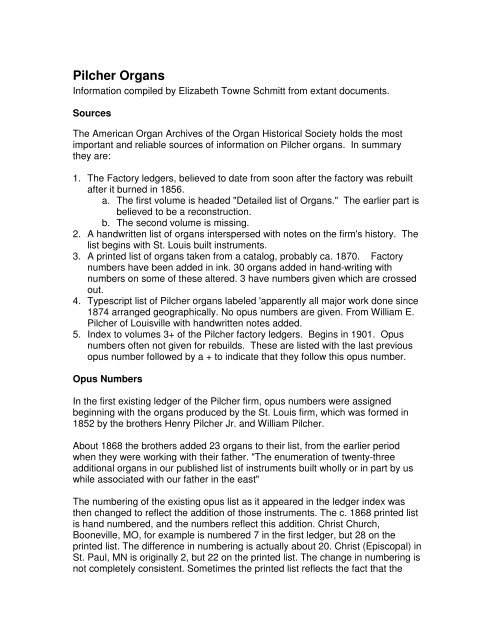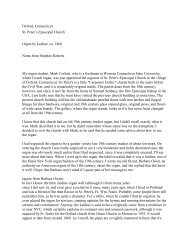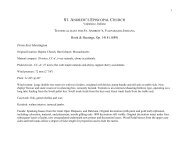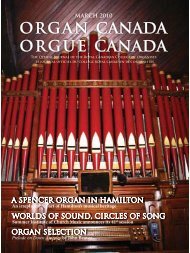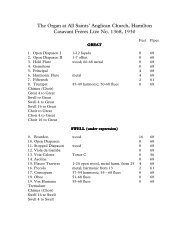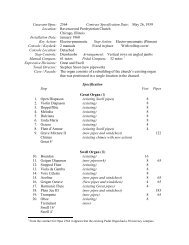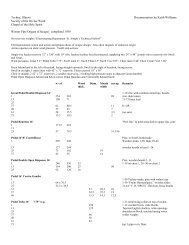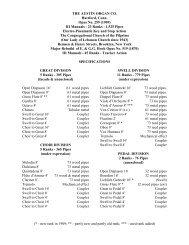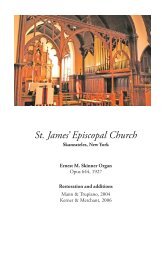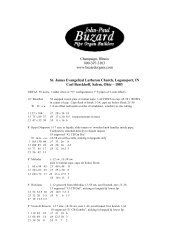Pilcher Organs - OHS Pipe Organ Database - Organ Historical Society
Pilcher Organs - OHS Pipe Organ Database - Organ Historical Society
Pilcher Organs - OHS Pipe Organ Database - Organ Historical Society
Create successful ePaper yourself
Turn your PDF publications into a flip-book with our unique Google optimized e-Paper software.
<strong>Pilcher</strong> <strong><strong>Organ</strong>s</strong>Information compiled by Elizabeth Towne Schmitt from extant documents.SourcesThe American <strong>Organ</strong> Archives of the <strong>Organ</strong> <strong>Historical</strong> <strong>Society</strong> holds the mostimportant and reliable sources of information on <strong>Pilcher</strong> organs. In summarythey are:1. The Factory ledgers, believed to date from soon after the factory was rebuiltafter it burned in 1856.a. The first volume is headed "Detailed list of <strong><strong>Organ</strong>s</strong>." The earlier part isbelieved to be a reconstruction.b. The second volume is missing.2. A handwritten list of organs interspersed with notes on the firm's history. Thelist begins with St. Louis built instruments.3. A printed list of organs taken from a catalog, probably ca. 1870. Factorynumbers have been added in ink. 30 organs added in hand-writing withnumbers on some of these altered. 3 have numbers given which are crossedout.4. Typescript list of <strong>Pilcher</strong> organs labeled 'apparently all major work done since1874 arranged geographically. No opus numbers are given. From William E.<strong>Pilcher</strong> of Louisville with handwritten notes added.5. Index to volumes 3+ of the <strong>Pilcher</strong> factory ledgers. Begins in 1901. Opusnumbers often not given for rebuilds. These are listed with the last previousopus number followed by a + to indicate that they follow this opus number.Opus NumbersIn the first existing ledger of the <strong>Pilcher</strong> firm, opus numbers were assignedbeginning with the organs produced by the St. Louis firm, which was formed in1852 by the brothers Henry <strong>Pilcher</strong> Jr. and William <strong>Pilcher</strong>.About 1868 the brothers added 23 organs to their list, from the earlier periodwhen they were working with their father. "The enumeration of twenty-threeadditional organs in our published list of instruments built wholly or in part by uswhile associated with our father in the east"The numbering of the existing opus list as it appeared in the ledger index wasthen changed to reflect the addition of those instruments. The c. 1868 printed listis hand numbered, and the numbers reflect this addition. Christ Church,Booneville, MO, for example is numbered 7 in the first ledger, but 28 on theprinted list. The difference in numbering is actually about 20. Christ (Episcopal) inSt. Paul, MN is originally 2, but 22 on the printed list. The change in numbering isnot completely consistent. Sometimes the printed list reflects the fact that the
organ has been moved. For example the original list showed St. Paul's Episcopalin Evansville, IN as number 1. The printed list assigns #21 to the Baptist Churchin Morris, IL which is the same organ, but relocated in the interim. In addition,one instrument has an old numbers assigned, but never received a new number.Three of the early instruments (appended in handwriting to the printed list) wereassigned new numbers, but those numbers were crossed out and no newnumbers were reassigned to them.In general, the old numbers appear in the ledger index and ledger, and the newnumbers appear on the printed list. The numbering then continues on the ledgerindex beginning with #119 at St. John's RC in Chicago. But that organ is listed inthe ledger itself as #96. The next organ on the list is St. Peter's Lutheran,Chicago which is assigned 120 in the ledger index, and 117 in the ledger, whichis then crossed out and corrected to 120. The name and number 120 arehandwritten on the bottom of printed list along with a number of additions,presumably built after the list was actually published.The <strong>Pilcher</strong>s appear to have inserted instruments and began numbering thenwith 117, but then found a couple more they could insert and corrected again forthat. The new opus number usually appears in the opus number field of thisdatabase, and the old one is entered into the notes. The new numbering providesthe longest most consistent numbering.The numbering problem exists only with the earliest ledger. The next ledger,which should cover the years 1891-1901 is missing entirely. The only theinformation available for most of the organs built during this period is a listcompiled by Wm. E. <strong>Pilcher</strong>. Judging from the gap between the last opus numberin the first ledger and the first opus number in the third ledger, some 40+ organsare missing from our lists.Most of the list is taken from the ledger indexes (inside the covers of ledgers 3-9)and not from the ledgers themselves. Only those entries that show a volumenumber and page number draw information from the actual ledger.Builder/Nameplate IdentificationThe nameplates used by the firm in the early years are not known. The fewexisting examples of these organs have been altered and no longer carry anoriginal nameplate. The instruments built before 1852 presumably carried onlythe name of Henry <strong>Pilcher</strong> (Sr.).After the sons, Henry <strong>Pilcher</strong>, Jr. and William opened their firm in St. Louis, theyoperated under several names. The firm seems to have been somewhat unstablein terms of personnel and probably finances, at least until Henry Jr. moved toKentucky and began a company with two of his sons, H. <strong>Pilcher</strong> and Sons. Thefirm descriptions below are primarily taken from these sources: the index to the
first <strong>Pilcher</strong> ledger and St. Louis, Chicago and New Orleans city directories. Theopus numbers shown are from the index to the first ledger. No opus numbers areknown for William <strong>Pilcher</strong>’s instruments.H. & W. <strong>Pilcher</strong>, 1852 directory (Morrison’s), 1854-55 directory (old Op. 1-20).In 1856-58 (old op. 21-28) the participants were Henry <strong>Pilcher</strong> (Sr.), Henry<strong>Pilcher</strong>, Jr. and William <strong>Pilcher</strong>. 1858 city directory lists H. & W. <strong>Pilcher</strong>. Adifferent 1858 directory (Bartletts) shows <strong>Pilcher</strong> & Sons.William <strong>Pilcher</strong> was alone 1858-1859 (old op. 29-38).Henry <strong>Pilcher</strong>, Jr. was alone 1859-1862 (old op. 39-46), the 1859 city directorylisting H. <strong>Pilcher</strong> & Son (Henry <strong>Pilcher</strong> Sr. and Jr.).Henry <strong>Pilcher</strong>, Jr. and William again together in St. Louis 1862 (old opus 47-49).Then Henry Jr. and William moved to Chicago. 1863-64 (old opus 50-61). <strong>Pilcher</strong>& Co. Nameplate on an 1864 instrument – <strong>Pilcher</strong> Bros., Chicago.In 1864 H. W. Chant also entered the firm, 1864-66 (old opus 62-70). <strong>Pilcher</strong>Bros. and ChantThe <strong>Pilcher</strong>s bought out Chant in 1866 (old opus 71-76). Firm renamed <strong>Pilcher</strong>Brothers 1866-1867 (old opus 77-86).Old Op. 87 and 88 are crossed out - but are shown in the ledger with a stoplistfor 88.Petition in bankruptcy filed 1867. In 1867-68 listed as “Warren Root (formerly<strong>Pilcher</strong> Bros.)”Business continued by Henry Jr. and William as <strong>Pilcher</strong> Brothers 1867-1869 (oldopus 87-95 and 119-121.William withdrew and went to Robins Nest, IL. Then next instruments werepresumably built by Henry alone, 1869-71 (new op. 122-125).William returned 1871-1873 (new op. 126-137). (Historic notes in the first ledgerindicate only that he returned to the firm in 1871. However, no <strong>Pilcher</strong>s are listedin the 1871 Chicago city directory – the year of the fire. William is listed with hisson William Henry as Wm. <strong>Pilcher</strong> & Son in the 1872 and 1873 Chicago citydirectories. Henry is listed separately in 1872, and no longer listed in 1873.)
H. <strong>Pilcher</strong> & Sons is the name on the index to the first ledger for the firm in KY in1874, Henry <strong>Pilcher</strong> Jr., Henry W. <strong>Pilcher</strong>, and William E. <strong>Pilcher</strong> (beginning withop. 138).The firm became Henry <strong>Pilcher</strong>'s Sons after Henry Jr's death in 1891.Meanwhile, William <strong>Pilcher</strong> and his family returned to St. Louis from 1874-1878.He then was briefly in Galveston, TX (1880 census) and Mobile, AL. By 1883 hewas in New Orleans Louisiana.From 1883 to 1892 the New Orleans city directories show the firm as <strong>Pilcher</strong>Bros.No firm listings between 1893 and 1905, though family members are listed, someworking as pipe organ builders with Philip Werlein Co..In 1906-1910 the firm is listed as W. & C. H. <strong>Pilcher</strong> (William and Charles H.),and in 1911 William is listed alone as an organ builder. He died in 1912.


